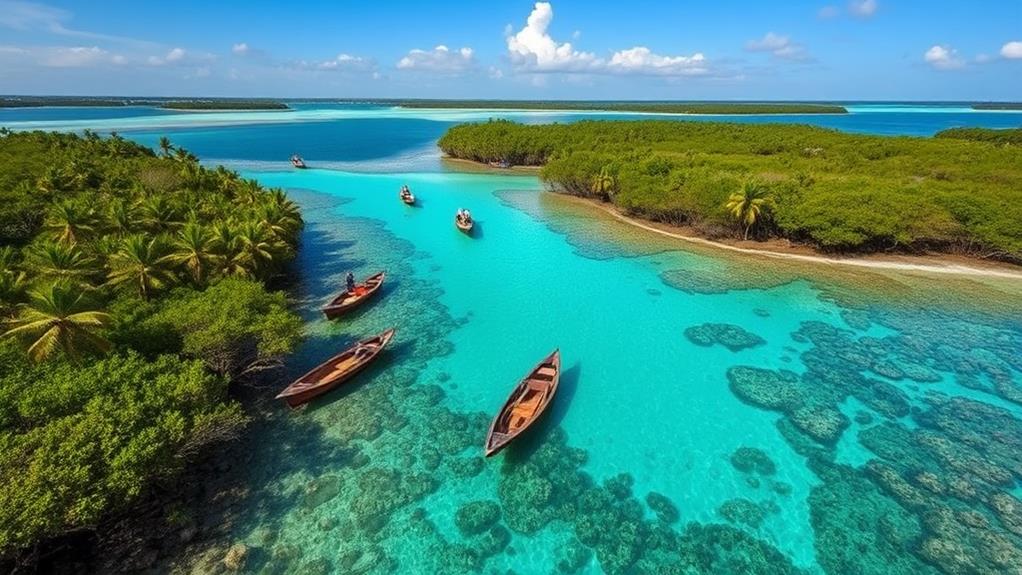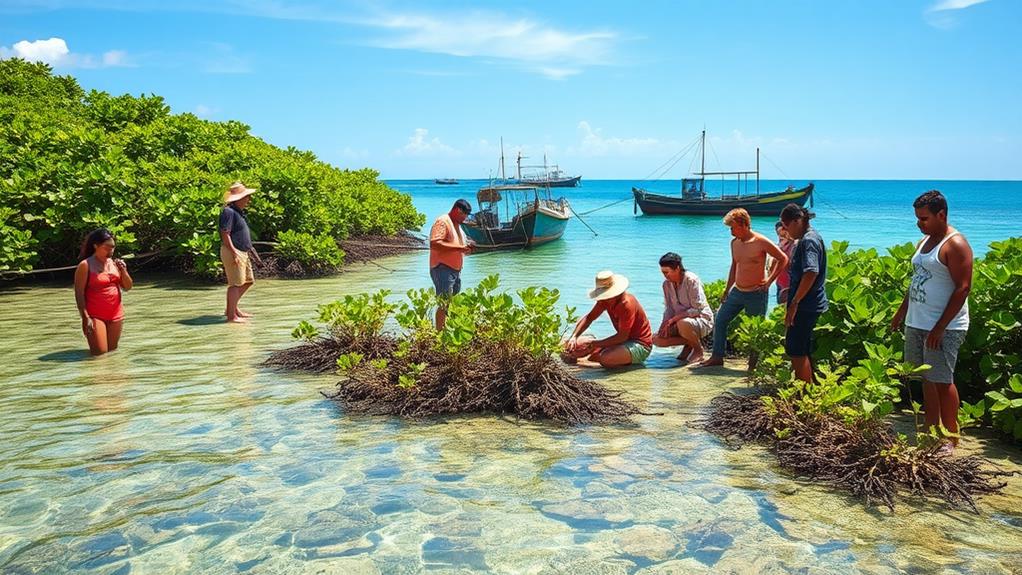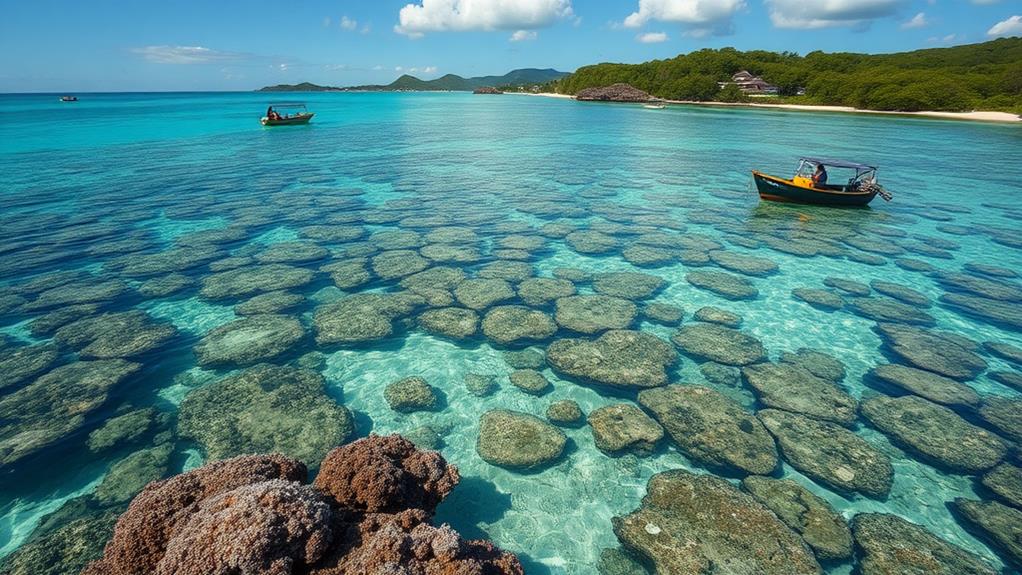Managing coastal resources and marine ecosystems in the Philippines requires Integrated Coastal Management (ICM) and creating Marine Protected Areas (MPAs). ICM helps to balance environmental health with community needs. For example, MPAs can protect specific areas from fishing to allow fish populations to recover.
Working with local communities is essential to promote sustainable practices. This means supporting fishing methods that do not harm the environment and ensuring that people have enough food. For instance, teaching fishermen about sustainable catch limits can help keep fish populations stable.
It is crucial to tackle overfishing, pollution, and habitat destruction. These problems threaten marine ecosystems. For example, reducing plastic waste can improve water quality, which helps marine life thrive.
Programs like the Coastal and Marine Ecosystems Management Program (CMEMP) aim to improve biodiversity and prepare for climate change. This program works on restoring habitats and protecting various species.
Investing in community education and capacity building empowers locals to protect their resources. For example, workshops can teach people about the importance of coral reefs and how to care for them.
Effective management of coastal resources not only helps the environment but also boosts local economies. Healthy ecosystems support tourism and fishing, which are important for many communities.
Overview of Coastal Management

Coastal management in the Philippines uses Integrated Coastal Management (ICM) to address problems caused by human activities on marine ecosystems. ICM brings together different groups, helping them work together to protect coastal and marine areas.
The Coastal and Marine Ecosystems Management Program (CMEMP) is an important part of this effort. It focuses on sustainable practices that help local communities and support healthy ecosystems.
A key strategy of CMEMP is the creation of Marine Protected Areas (MPAs). These areas aim to conserve at least 10% of coastal and marine spaces, which supports Sustainable Development Goal 14.5. By 2019, CMEMP had assessed and mapped over 2,075 hectares of coastal ecosystems, surpassing its goal.
These efforts not only protect biodiversity but also provide job opportunities for local people.
Effective coastal management requires working with local communities. By creating rules that promote sustainable fishing practices and protect important habitats, we can help conserve coastal ecosystems.
This ensures that these areas remain healthy for future generations.
Key Objectives of CMEMP
The Coastal and Marine Ecosystems Management Program (CMEMP) aims to improve the health of coastal areas and support local communities. The program focuses on creating Marine Protected Areas (MPAs) and using sustainable practices. Here are the main objectives:
- Support food security by managing coastal and marine resources sustainably. For example, fishing practices can be regulated to prevent overfishing.
- Enhance climate change resiliency for future generations. This can involve restoring mangroves, which protect shorelines and absorb carbon dioxide.
- Promote integrated coastal management and ecotourism initiatives. This means combining conservation efforts with tourism that benefits the local economy and environment.
- Reduce threats to ecosystems and encourage positive values among stakeholders. For instance, educating the community about the importance of biodiversity can lead to stronger conservation efforts.
- Implement monitoring and evaluation processes to assess how well the program is working. Regular checks can help determine if goals are being met.
CMEMP supports Sustainable Development Goal (SDG) 14, which aims to protect at least 10% of coastal and marine areas.
The program empowers stakeholders to manage resources in a sustainable way. Additionally, by improving the skills of Department of Environment and Natural Resources (DENR) staff, integrated coastal management practices can be more effective.
Collaborative Approaches in Implementation

Collaborative approaches are essential for the successful implementation of the Coastal and Marine Ecosystems Management Program (CMEMP). The program brings together the Department of Environment and Natural Resources (DENR), local government units (LGUs), academic institutions, and NGOs to manage coastal resources effectively.
For example, in 2019, DENR assisted 69 LGUs in promoting biodiversity management and sustainable practices.
The program has established six marine protected area (MPA) networks to protect important habitats and improve ecosystem services for coastal communities. This effort led to the creation and maintenance of 48 MPAs under the National Integrated Protected Areas System (NIPAS). Civil society organizations play a crucial role in this process.
Regular monitoring and evaluation are important in CMEMP. These processes help stakeholders check progress and effectiveness openly.
Challenges Facing Marine Ecosystems
Marine ecosystems in the Philippines face serious challenges that threaten their health and diversity. Overfishing is a major problem, as unsustainable fishing practices reduce fish populations. This not only affects the number of fish but also harms local communities that rely on fishing for their livelihoods.
For example, if too many fish are caught, there may not be enough left to reproduce, leading to fewer fish in the future.
Pollution is another significant issue. Waste from land, like plastic and chemicals from farms, pollutes the water. This pollution can cause poor water quality, which harms marine animals and plants.
For instance, when fertilizers run off into the ocean, they can lead to excess algae growth, which depletes oxygen levels and can kill fish.
Climate change is also affecting marine ecosystems. Rising sea levels and higher temperatures can destroy habitats like coral reefs and mangroves. These habitats are important for many species and help protect coastlines from storms.
Habitat loss due to coastal development, like building homes and roads, is another challenge. This development often destroys areas where fish and other marine life live, making it harder for them to survive.
For example, when mangrove forests are cut down, it removes a critical area for fish to breed and find food.
Finally, invasive species can harm local ecosystems. Non-native species can outcompete and threaten local fish and plants.
For example, when a new fish species is introduced to an area, it may eat the same food as native fish, leading to a decline in the native population.
To protect marine ecosystems, it's essential to use coastal resources sustainably and implement strong management strategies.
Immediate action is needed to maintain the balance of these ecosystems and ensure the survival of diverse marine life.
Conservation Strategies and Best Practices

To protect marine ecosystems effectively, establishing Marine Protected Areas (MPAs) is crucial. These areas aim to conserve at least 10% of coastal and marine regions, in line with SDG 14.5. In the Philippines, there are 48 MPAs under the National Integrated Protected Areas System (NIPAS), which help maintain ecosystem services.
Another successful method is community-based conservation initiatives. For example, in Chonburi, Thailand, local efforts led to a 94% increase in crab catch. This shows that when locals are involved, they can help implement sustainable practices effectively.
Additionally, the Coastal and Marine Ecosystems Management Program (CMEMP) aims to reduce marine pollution by 2025, focusing on important issues like coastal eutrophication.
To strengthen these initiatives, capacity building and education programs for local communities are vital. In the Philippines, 69 local government units received technical help to promote sustainable fishing.
Combining scientific knowledge with adaptive management also helps protect coral reefs, supporting biodiversity and ecosystem resilience. By focusing on these strategies, you can play a significant role in protecting coastal and marine ecosystems in the Philippines.
Future Directions for Sustainability
A strong network of Marine Protected Areas (MPAs) is crucial for sustainable management of coastal resources in the Philippines. These areas help protect marine life and improve fish populations. Here are some clear directions for the future:
1. Reduce fishing efforts around MPAs. This helps marine ecosystems recover and thrive. For example, limiting the number of fishing boats in these areas allows fish to grow and reproduce more effectively.
2. Invest in research and adaptive management. Ongoing studies can improve Community-Based Coastal Resource Management (CBCRM) efforts. This means learning from local experiences and adjusting strategies based on what works best.
3. Strengthen partnerships among local governments and communities. Collaboration can help overcome rules that limit cooperation. For instance, local fishermen and government officials can work together to enforce regulations that protect MPAs.
4. Focus on capacity building and education. Training local communities about environmental issues can empower them to take action. Workshops on sustainable fishing practices can lead to better protection of marine resources.
5. Create plans to address climate change impacts. Coastal ecosystems are vulnerable to changing weather patterns. For example, developing strategies to protect mangroves can help shield coastlines from storms and rising sea levels.
In summary, these steps can lead to healthier and more sustainable coastal resources in the Philippines.
Questions and Answers
What Are the Coastal and Marine Resources in the Philippines?
The Philippines has rich coastal habitats such as coral reefs and mangrove forests. These ecosystems support diverse wildlife, including many species of fish and sea turtles. For example, coral reefs provide shelter and food for fish, while mangrove forests serve as nursery grounds for young fish. These habitats also offer important services like protecting coastlines from erosion and supporting local fishing and tourism. Overall, these coastal and marine resources are vital for both the environment and the economy.
What Are the Coastal Resource Management Laws in the Philippines?
Coastal laws in the Philippines focus on marine resource conservation. For example, the government sets rules to protect fish populations and their habitats. Fisheries management policies help regulate fishing practices. These policies include limits on the number of fish that can be caught and restrictions on fishing methods to prevent overfishing.
Environmental protection regulations are also important. They aim to safeguard coastal ecosystems, like mangroves and coral reefs. For instance, illegal dumping of waste in coastal areas is prohibited to maintain clean water and healthy marine life.
Community engagement strategies encourage local people to participate in managing coastal resources. This means involving communities in decision-making processes about how to use and protect their coastal areas.
Sustainable development guidelines help ensure that coastal areas are used wisely. These guidelines promote activities that benefit both the environment and local economies, such as eco-tourism.
Lastly, habitat restoration initiatives work to repair damaged coastal ecosystems. An example is replanting mangroves to improve biodiversity and protect shorelines from erosion.
What Is a Coastal and Marine Ecosystem Management Program?
A coastal and marine ecosystem management program is designed to promote sustainable use of ocean and coastal resources. This program focuses on conserving biodiversity, which means protecting different species of plants and animals in these areas. For example, protecting coral reefs helps maintain fish populations.
The program encourages community involvement. When local people participate, they can share valuable knowledge and help protect their environment. For instance, fishermen can contribute to better fishing practices.
It also requires strong policies to guide actions. Effective laws can protect sensitive habitats like mangroves and wetlands, which are essential for many marine species.
Climate resilience is another key aspect. This means preparing for changes in climate, like rising sea levels, which can impact coastal areas. For example, restoring coastal dunes can help protect shorelines from storms.
What Is Coastal and Marine Resources Management?
Coastal and marine resources management is about using sustainable methods to protect our oceans and coasts. Sustainable practices help maintain healthy ecosystems. For example, protecting coral reefs can support fish populations and improve water quality.
Community involvement is important for successful management. Local people often participate in beach clean-ups or conservation programs, which helps raise awareness about the importance of their environment.
Biodiversity conservation means protecting different types of plants and animals. For instance, creating marine protected areas can help endangered species recover.
Fishing regulations are rules that help prevent overfishing. These rules can include limits on catch sizes and specific fishing seasons to allow fish populations to grow.
Pollution control is necessary to keep our waters clean. Efforts such as reducing plastic waste and using green technologies can significantly improve water quality.
Habitat restoration involves repairing damaged ecosystems. For example, replanting mangroves can help prevent erosion and provide shelter for marine life.
Climate adaptation helps communities deal with changes in weather patterns. For instance, building seawalls can protect coastal areas from rising sea levels.
Stakeholder collaboration includes working together with different groups, such as government agencies, local businesses, and tourists, to promote marine tourism. By doing so, they can create programs that benefit both the environment and the economy.